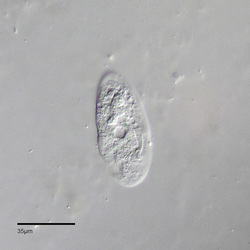Take a look and tell me what you think.
|
I have completed a new training document for operators doing microscopic exam of wastewater. The short course covers the basic bacteria type, protozoa, and other higher life-forms seen in biological waste treatment units. In addition to helping identify the organism, I have provide hints as to their ecology and what promotes their growth in the unit.
Take a look and tell me what you think.  Flagellate at 1000x magnifcation. Flagellate at 1000x magnifcation. The typical flagellate found in wastwater treatment plants appear as small ovoid shapes that move in the liquid phase surrounded by much smaller free bacteria. Using a single or multiple flagella, long whip-like structures, for motion; these single celled protozoa are one of the first indicator microbes seen in a wastewater treatment system. In the system they consume the free floating bacteria cells and adsorb some soluble organics for their nutritional requirements. (Note: there are some photosynthetic flagellates found usually in ponds, lakes and streams but not as common in wastewater.) You see flagellates at the early stages of wastewater treatment or when there is log phase growth of bacteria. In lagoon systems, you will often find flagellates predominating near the inlet where dissolved oxygen is low & soluble BOD high. If seen near the effluent, this indicates some type of upset condition. Common triggers include - (1) high hydraulic loads, (2) increased organic loadings, (3) pond turnover, and (4) problems with dissolved oxygen concentrations. In activated sludge or fixed film systems, the sudden appearance of flagellates can indicate an increase in organic loadings or follow a toxic event that killed off significant portion of the living bacteria found in the MLVSS or biofilm. Either event merits further investigation into what is causing the increase in flagellate populations. |
AuthorErik Rumbaugh has been involved in biological waste treatment for over 20 years. He has worked with industrial and municipal wastewater facilities to ensure optimal performance of their treatment systems. He is a founder of Aster Bio (www.asterbio.com) specializing in biological waste treatment. Click to set custom HTML
Archives
April 2024
|

 RSS Feed
RSS Feed